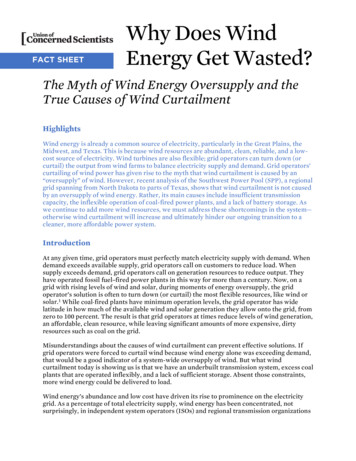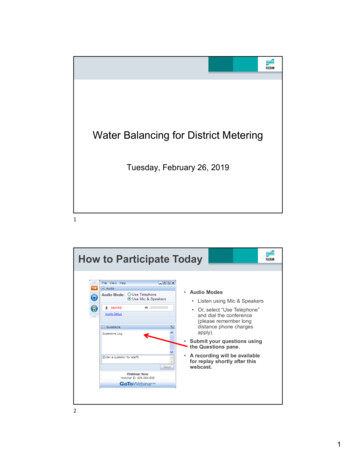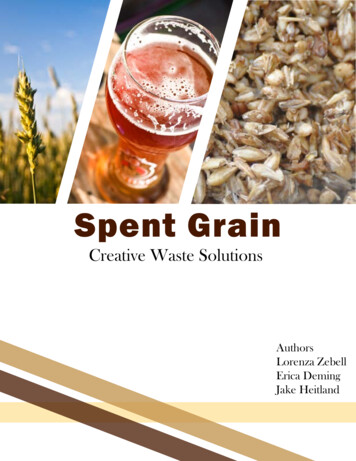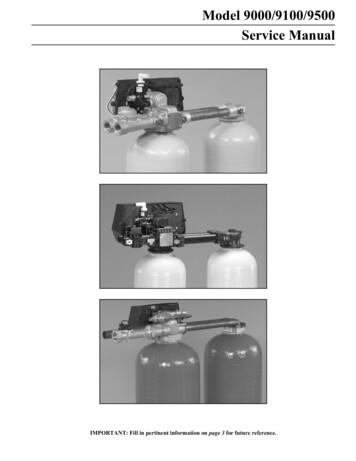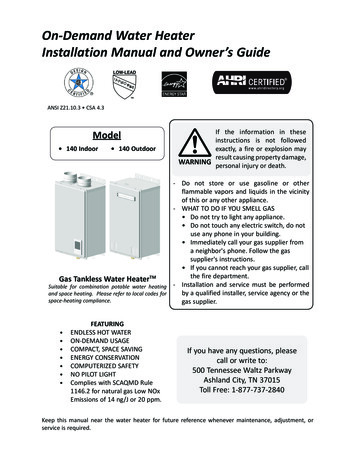
Transcription
LBNL-5115EWater and Energy WastedDuring Residential ShowerEvents: Findings from a PilotField Study of Hot WaterDistribution SystemsJim LutzEnergy Analysis DepartmentLawrence Berkeley National LaboratoryBerkeley, CA 94720September 2011This work will be presented at the 2012 ASHRAE WinterConference.This work was sponsored by the Department of WaterResources, Office of Water Use Efficiency and Transfers,under contract No. 4600004199This work was supported by the U.S. Department ofEnergy’s Office of Energy Efficiency and RenewableEnergy, Building Technologies Program under ContractNo. DE-AC02-05CH11231.
DISCLAIMERThis document was prepared as an account of work sponsored by the United StatesGovernment. While this document is believed to contain correct information, neither theUnited States Government nor any agency thereof, nor The Regents of the University ofCalifornia, nor any of their employees, makes any warranty, express or implied, orassumes any legal responsibility for the accuracy, completeness, or usefulness of anyinformation, apparatus, product, or process disclosed, or represents that its use would notinfringe privately owned rights. Reference herein to any specific commercial product,process, or service by its trade name, trademark, manufacturer, or otherwise, does notnecessarily constitute or imply its endorsement, recommendation, or favoring by theUnited States Government or any agency thereof, or The Regents of the University ofCalifornia. The views and opinions of authors expressed herein do not necessarily state orreflect those of the United States Government or any agency thereof or The Regents ofthe University of California.
ABSTRACTHeating water is one of the most energy-consumptive activities in a household, accounting for about 49 percentof California’s residential natural gas consumption (Palmgren et al. 2010). Data collected during a pilot field studyin California indicate that significant amounts of water and energy are wasted while waiting for hot water to bedelivered to the point of end use. We calculate the water and energy wasted during shower events from datacollected using a wireless sensor network that monitored water flows and temperatures in three single-familyresidences. The total calculated water waste for a typical shower event was 30 percent. Forty-one percent of the hotwater energy for the same event was wasted. This relatively low efficiency highlights the importance of examiningfurther the energy and water waste of residential hot water distribution systems in order to improve them.BACKGROUNDThis paper examines the waste of water and energy associated with the hot water distribution systems insideresidences. Figure 1 shows a schematic view of a typical hot water distribution system in a single-family residence.The line labeled ”Hot Water” depicts the distribution system that conveys hot water from the water heater to eachend-use location within the house.EnergyHotWaterFixture erDrainIndoorBoundaryFuelSourceFigure 1. Typical residential hot water distribution system.WaterSourceSewer
There is a paucity of both studies and data on the water and energy wasted as part of hot water delivery and usein residential settings. The Residential End Uses of Water Study (REUWS) remains the best description ofresidential end uses of water (Mayer et al. 1999). REUWS employed compact data loggers to measure whole-housewater consumption. Using flow trace analysis, water draws were assigned to end uses for each house in the study. Aflow trace, which records flow through a water meter at 10-second intervals, provides sufficient resolution toidentify the patterns associated with various types of fixtures in a household. The flow pattern associated withflushing a toilet, for instance, differs from that associated with running a dishwasher.Other studies also have used flow trace analysis to disaggregate hot water draws by end use (Lowenstein andHiller 1996, 1998). Some studies have used temperature probes on pipes near end uses to help disaggregate hotwater draws (Weihl and Kempton 1985; Bohac et al. 2010). In one case the analysis was extended to estimate theenergy efficiency of the piping used to deliver hot water (Kempton 1988).The losses of energy and water attributable to the design of hot water distribution systems have been notedpreviously (Lutz 2004). In the case of showers, waiting for cooled-off hot water to clear from the pipe that connectsthe water heater to the shower represents structural waste. Water that is hot enough, but runs down the drain beforethe user makes use of the shower, represents behavioral waste. The useful portion of the shower event is whensomeone is using the shower water to bathe.Lutz (2004) used the REUWS data on total volume and duration of water draws, along with the peak and modeflow rates during draws, to develop an equation for calculating wasted hot water during shower events (Lutz 2004).Of the shower events in the REUWS database, 26,000 met the criteria for evaluation by the equation. Applying theequation, Lutz (2004) calculated the average waste volume for the examined showers as 3.48 gallons (13.2 L).According to the REUWS report, the average shower uses 17.2 gallons (65.1 L). For the 26,000 showers, therefore,the wasted volume of water represents an average of 20 percent of the shower volume. All the calculations in Lutz(2004) were noted as rough approximations, because they were not based on data collected at the point of end use.That paper called for collecting field measurements of how hot water is used and wasted in a cross-section ofresidences nationwide; the current study is the first to collect data directly at the site of an end use.METHODSThe pilot phase of a California residential field study involved measuring water flow and temperature at threesingle-family residences for about one week each. All the houses were concrete slab-on-grade construction. The
plumbing for both hot and cold water was copper pipe. All three houses employed natural draft gas storage waterheaters. In the field study, data were collected directly at showerheads, sink faucets, and dishwashers. Figure 2 is aschematic of the points at which water temperature and flow were measured during the pilot ucet2hot water distribution systemcold waterWaterHeaterHouseWaterMeterGasSubmeterfrom utility gas meterWireless flow & temperature sensorsComputer(PC)Wireless base motefrom water mainsFigure 2. Points at which water flow and temperature were measured during pilot project.As described in detail in Lutz et al. (2011), water flow was measured with an inline turbine meter, andtemperature was measured with a thermistor probe inserted into the water flow (Lutz et al. 2011). The data acquiredby the sensors was read and transmitted to a local on-site computer by a wireless sensor network. Once per day thedata were sent via cell modem to a central server. The study established the feasibility of using the wireless sensornetwork to measure directly the waste of water and energy in hot-water distribution systems. Figure 3 shows the
wireless sensor network Lutz et al. (2011) developed to measure flow and temperature of water at the water heaterand at several end-use points of the hot water distribution system.Figure 3. Wireless data acquisition system.The sensor network was intended to demonstrate a method for collecting water flow and temperature data fromevery indoor end-use point and at the water heater in one-second intervals when water was flowing. The scheme toprocess the data and transmit it to the central server included several automated scripts and batch files. Onceuploaded to the server, the field measurement data were processed sequentially by several software scripts. At thecentral data-processing site, the field data were analyzed and aggregated into summary data about individual hotwater draws. The data were processed record by record. The time at the start of the draw, the total duration of thedraw, the total volume of water for the draw, the weighted average temperature during the draw, and the time since
the previous draw were calculated and recorded for each draw. The time until hot water arrived at the site of an enduse could be calculated and recorded as well.The current analysis focuses on the flow and temperature data collected at showerheads only. Figure 4 showsthe system for measuring the amounts of water and energy wasted through the pipe and shower. We did notmeasure the energy going down the drain.sensorsHotWaterWater Heater OutletMixingValveShowerheadShowerTubWater Heater aryFuelSourceWaterSourceDrainSewerFigure 4. Locations of measurement points for calculating shower waste.Figure 5 shows the sensors that measure water flow and temperature installed at a showerhead. Similar sensorswere installed on the inlet and outlet of the water heater.We examined the data from 36 shower events in three households to evaluate the water and energy wastedduring shower events. Because of the developmental nature of the wireless sensor network and difficulties withvarious pieces of equipment, we were unable to collect complete data for most shower events. The resulting data,
along with some reasonable extrapolation and cleaning, allowed for complete analysis of five shower events.Missing data were filled in via linear interpolation or, when necessary, copying water flow from water heater outletto inlet. Obvious outliers were removed.Figure 5. Flow and temperature sensors installed at showerhead.RESULTSFigure 6 shows the type of data collected by the wireless sensor network during a typical shower event. Thetraces in the top part of the figure show the temperature of the water leaving the water heater, at the showerhead, andwhen it enters the water heater. The temperature is indicated by scale along the right axis of the chart. The lower setof traces represents flow measurements at the showerhead, entering the water heater and leaving the water heater.The flowrate is shown on the left axis of the chart.
Figure 6. Flow and temperature records for typical shower event (2009-03-22).
We assumed that the useful portion of a shower starts when the temperature at the showerhead is no longerbeing adjusted and ends when water flow stops. For the shower event shown in Figure 6, we considered the showeras having started at 8:53:58 and ended at 8:59:38. The water drawn (and time) that pecedes the useful portion of theshower is considered to be unused and, therefore, wasted. The energy content of the hot water measured at the waterheater outlet and at the showerhead was calculated relative to the temperature of the cold water delivered to thehouse. We used the temperature of the water at the inlet to the water heater during the last minute of a shower eventas a proxy for temperature of the water delivered to the house. We calculated the useful energy of the water at theshowerhead and at the water heater outlet as shown in equation 1.E h(ti ) h(t0 ) M (ti ) vii(1)where,h molar enthalpy, Btu/mol (J/mol),M molar density, mol/gal (mol/L),ti temperature at time i, ºF (ºC)t0 mean temperature of water heater inlet water for the last minute of shower, ºF (ºC), andvi volume of water measured at time i, gal (L).We calculated the energy delivered by the water heater as the energy content of the water leaving the waterheater during the entire shower event. The useful energy delivered at the showerhead was calculated as the energycontent of the water measured at the showerhead for the useful portion of the shower only. The wasted energy is thedifference between those two values.As depicted in Figure 6, the user initiated the shower event by turning the water on full hot. The hot waterleaving the water heater, shown by the top trace, almost immediately became fully hot [approximately 110ºF(43 C)]. The chart also shows that the water entering the water heater initially was hot. This initial temperaturereflects the water heater’s warming effect on the water in the inlet pipe close to the heater. The inlet watertemperature then decreased as new, unwarmed water arrived at the water heater. The unwarmed water entering the
water heater, was about 60ºF (16ºC) after the hot water in the line had cleared. For most of the shower, the water atthe showerhead was close to 104ºF (40ºC ).When the water initially was turned on, the volume of water flowing into the water heater matched both theflow out and the flow at the showerhead, as shown by the bottom three traces. This matching pattern indicates thatthe valve at the shower was set for hot water only. Shortly thereafter, the flow rate at the showerhead diverged fromthat at the water heater, indicating that the user had added cold water to adjust the shower’s water temperature. Thisdivergence also is reflected in the drop shown by the shower temperature trace. The flow at the showerhead wasthen a mixture of hot and cold water.About a minute passed before the temperature of the water at the showerhead exceeded the user’s preferredshowering temperature. The water at the showerhead never reached the temperature at the water heater outletbecause of heat losses along the water distribution route. Another minute or so passed as the user added cold waterto obtain the desired shower temperature. This second minute reflects the behavioural waste referred to earlier. Afteradjusting the water temperature, the user began showering. Part way through the shower, the user adjusted thetemperature upward a few degrees. Figure 6 shows the entire data stream from turn-on to turn-off. We assume thatthe shower started when the water temperature at the showerhead became stable, at 8:53:58. All water used beforethat time is wasted. Waste occurred during three periods in the event: the period spent waiting for the water to attainfull temperature at the showerhead; the period before the user began adjusting the water temperature; and the timethe user spent adjusting the water temperature.Figure 7 shows a shower that has a double temperature peak at the showerhead. The first peak likely is a pulseof hot water remaining in the pipe from a prior use. The second peak shows when the user adjusted the showertemperature, causing the flow rate at the showerhead to diverge from the flow rate through the water heater. Theuser adjusted the water temperature by changing the relative flow of hot and cold water while retaining a constantflow at the showerhead. Before the user adjusted the temperature, some cold water was already flowing to theshower. This is visible as more water was flowing through the showerhead than through the water heater. This figuremay reflect a shower facility equipped with a valve that allows adjustments temperature only.Figure 8 shows a situation in which the temperature setpoint of the water heater is dangerously high. Water atthe temperatures indicated in the figure can produce scalding and third-degree burns in less than 3 seconds(ASHRAE 2011). Like the event depicted in Figure 7, the shower event shown here appears to have a constant-flow
shower valve. Figure 8 also indicates that more water was flowing through the water heater than coming out of theshowerhead, which could indicate a combination shower bathtub with a leaky tub spout diverter. The tub spoutdiverter probably leaked throughout the shower event. The leaking water was not included in the calculation ofwasted water.Figure 9 represents a relatively efficient shower event, in which the user apparently entered the shower almostas soon as water reached the desired temperature at the showerhead. The shower facility for the event recorded inFigure 9 is located close to the water heater. Notice that at the beginning of the event more water is flowing throughthe showerhead than through the water heater. This figure indicates that the user pre-set the shower valve to includea small amount of cold water flow initially, then added more cold water when it became clear that the temperaturewas not as desired.DISCUSSIONTable 1 summarizes the amounts of time associated with five shower events at three single-family residences.Table 1 shows that the total duration of each of the five shower events differed significantly (from 5 to 8minutes), although the time of actual showering was fairly consistent. The percent of time wasted varied from 22percent to 48 percent.Table 2 summarizes the volumes of water used and wasted during the same five shower events as delineated inTable 1.From the data in Table 2 we see that the percent of wasted water does not consistently reflect the total volumeof water used, in that 20 percent of the water for the 12.5 gallon (47.2 L) shower event was wasted, whereas 31percent of the water was wasted for the 10.5 gallon (39.7 L) shower event.Table 3 summarizes the amount of energy used and wasted during the same five shower events.All of the shower events wasted a higher percentage of energy than of water. Both values track well for mostshower events. The shower event of February 27, however, is an outlier. That event wasted a little more than 31percent of the water used for it. Almost 70 percent of the energy the water heater provided in the form of hot waterfor that event was wasted .
Figure 7. Flow and temperature records for a shower event on 2009-03-21.
Figure 8. Flow and temperature records for a shower event on 2009-02-27.
Figure 9. Flow and temperature records for a shower event on 2009-01-07.
Table 1. Durations of five shower eventsDateTotal Duration ofDuration ofWater :11Time Wasted(minutes)% of 7.0%41.8%34.5%4:064:224:164:345:404:36Table 2. Water used and wasted during five shower eventsDateTotal Water FlowWater Used 009average12.5 gal ( 47.2 L )10.5 gal ( 39.7 L )11.6 gal ( 44.0 L )11.6 gal ( 43.8 L )15.5 gal ( 58.9 L )12.3 gal ( 46.7 L )10.4 gal ( 39.4 L )8.0 gal ( 30.2 L )8.4 gal ( 31.7 L )9.2 gal ( 34.7 L )11.5 gal ( 43.4 L )9.5 gal ( 35.9 L )Table 3. Energy used and wasted during five shower eventsDateTotal Energy FromEnergy Used at ShowerWater average5169 BTU ( 5.454 MJ )4335 BTU ( 4.573 MJ )4151 BTU ( 4.379 MJ )4192 BTU ( 4.423 MJ )5499 BTU ( 5.801 MJ )4669 BTU ( 4.926 MJ )4114 BTU ( 4.340 MJ )2554 BTU ( 2.695 MJ )2847 BTU ( 3.004 MJ )3122 BTU ( 3.294 MJ )3902 BTU ( 4.117 MJ )3308 BTU ( 3.490 MJ )Water Wasted2.1 gal ( 7.8 L )2.5 gal ( 9.4 L )3.3 gal ( 12.3 L )2.4 gal ( 9.0 L )4.1 gal ( 15.5 L )2.9 gal ( 10.8 L )Energy Wasted1055 BTU ( 1.113 MJ )1780 BTU ( 1.878 MJ )1304 BTU ( 1.375 MJ )1070 BTU ( 1.128 MJ )1596 BTU ( 1.684 MJ )1361 BTU ( 1.436 MJ )% of WaterWasted19.9%31.2%39.0%26.0%35.7%30.2%% of ONSWhen Lutz (2004) performed a rough calculation using data from the REUWS report and found an average of20 percent of the volume of shower water was wasted, the approximation probably was low. Based on the datarecorded for this study, the average volume of wasted shower water for showers is closer to 30 percent. The averagewaste of energy in the hot water is about 40 percent.Further study could benefit from evaluating the type, diameter, and length of the piping between the waterheater and shower. Such an evaluation would enable a prediction of the "structural" water waste from information in
the ASHRAE Handbook, Service Water Heating chapter, to be compared to what was measured in this study andused to calculate what the actual flow to pipe volume ratio was for a given shower event. (ASHRAE 2011)An additional factor that could be evaluated is the effect of a shower having a single valve or separate valves forhot and cold water and whether valve style affects shower flow volumes.In general, the delivery efficiencies indicated by Tables 1 through 3 should be accounted for when determiningboth the water and energy consumption of showering. Further research is needed to better quantify the types oflosses and determine ways to reduce them. Clearly the plumbing related to providing showers warrants thoroughexamination and improvement.ACKNOWLEDGEMENTSThis work was supported by the California Department of Water Resources through the U.S. Department ofEnergy under Contract No. DE-AC02-05CH11231.REFERENCESASHRAE. 2011. Heating, Ventilating, and Air-Conditioning Applications Handbook.Chapter 50, Service WaterHeating. Atlanta: American Society of Heating Refrigerating and Air-Conditioning Engineers, Inc.Bohac, D., B. Schoenbauer, M. Hewett, M.S. Lobenstein, and T. Butcher. 2010. Actual Savings andPerformance of Natural Gas Tankless Water Heaters. Center for Energy and Environment, Minneapolis MN,August 30.Kempton, W. 1988. Residential hot water: A behaviorally-driven system. Energy 13:107-114.Lowenstein, A., and C.C. Hiller. 1996. Disaggregating residential hot water use. ASHRAE Transactions:102:1019-1027.Lowenstein, A., and C.C. Hiller. 1998 Disaggregating residential hot water use—Part II. ASHRAE Transactions104:1852-1863.Lutz, J.D. 2004. Feasibility study and roadmap to improve residential hot water distribution systems. AmericanWater Works Association Annual Conference, Orlando, Florida.Lutz, J.D., P. Biermayer, and D.A. King. 2011. Pilot phase of a field study to determine waste of water andenergy in residential hot-water distribution systems. ASHRAE Transactions 117:755-768.
Mayer, P.W., W.B. DeOreo, E.M. Opitz, J.C. Kiefer, W.Y. Davis, B. Dziegielewski, and J.O. Nelson. 1999.Residential End Uses of Water. Denver:Palmgren, C., N. Stevens, M. Goldberg, R. Barnes, and K. Rothkin. 2010. Consultant report: 2009 CaliforniaResidential Appliance Saturation Study, Executive summary. California Energy Commission, Sacramento. October.Weihl, J.S. , and W. Kempton. 1985. Residential hot water energy analysis: Instruments and algorithms. Energy andBuildings 8(3):197-204.
The line labeled "Hot Water" depicts the distribution system that conveys hot water from the water heater to each end-use location within the house. Fixture or Appliance Drain Fuel Source Water Source Sewer Water Heater. Indoor Boundary. Hot Water Cold Water Mixed Temperature Water Energy. Figure 1. Typical residential hot water .
